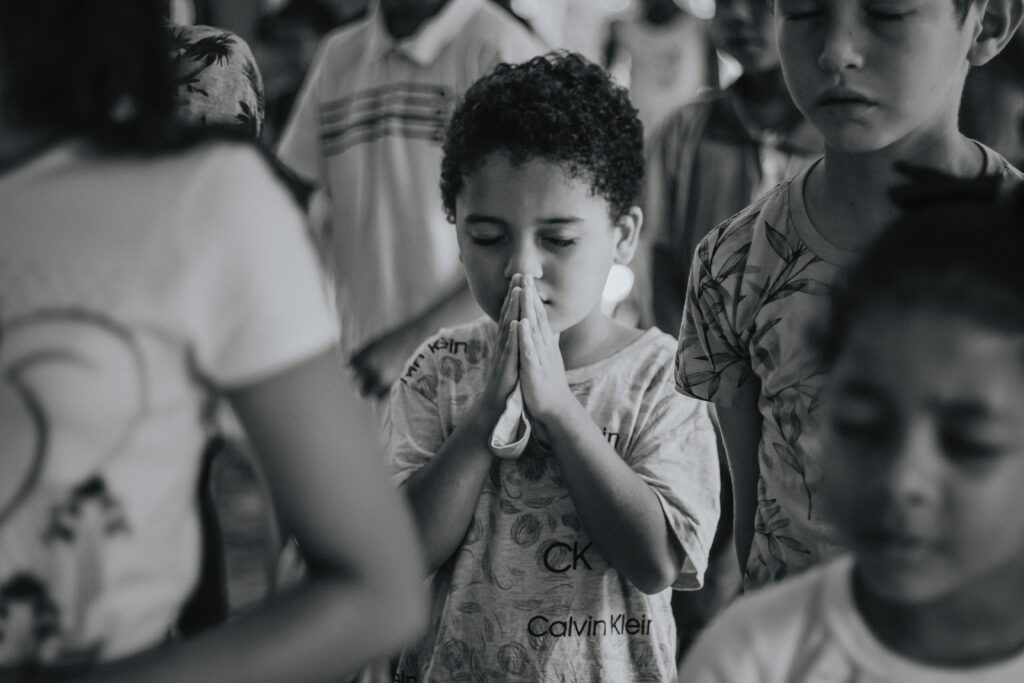It was evening around a fire at the end of a great summer camp day! We had about seventy-five children ranging from fourth to sixth grade.
The day had been filled with games, Bible study, swimming, soccer bopper, and a lot of fun. The sun had set and one of the groups had finished a skit and the worship had begun.
My friend Randy was really gifted at leading worship with children, and you could sense the presence of God. After a couple of beautiful praise songs, we began singing “I Love You LORD” a popular chorus of that day. As we sang, I noticed children closing their eyes, tears streaming down some faces and then arms raised to heaven in absolute abandon.
The same children I had chased with flour-filled socks, were worshipping the LORD in the most holy way that touched my soul deeply. Next to me was Kelly, a fifth-grader, who had her eyes closed singing her heart out, arms raised in a moment I will never forget. Four hours earlier her team had won the baby food eating contest and now she was immersed in the awe and wonder of God.
This is the essence of the Contemplative Reflective Model. Although not widely known in many evangelical churches it is found commonly in the Anglican, Lutheran, and “High-Church” children’s ministry.
When examining this model, you can find several distinctive elements.
The Contemplative Reflective Model of Children's Ministry

Environment – In this model, the room and its furnishings are part of the ministry. A quiet space, slow pace, and the eliminations of “frills” create an environment where children can encounter God. An environment should encourage children to be in awe of God.
Repetition and Ritual – Children love repetition, patterns, motions, and keywords that are used over and over. In this model liturgy, set patterns of activity and repeated songs, words, and activities reinforce the teaching and can engage the children in meaningful spiritual ways. Participatory learning through activities is essential.
Worship – In the Contemplative Reflective Model worship is a noun and verb. As a noun, it describes an encounter with God. As a verb, it is something a child does. Worship is the space in which children express and experience the awe and wonder of God. Worship is where children can encounter God.
The Strengths and Weaknesses Of The Contemplative Reflective Model

The strength of this model is taking the spiritual life of children seriously, recognizing children are able to ponder and think about God.
They can have age-appropriate personal spiritual encounters with God and develop a genuine sense of wonder. It offers a fresh alternative to the “entertainment” elements of US culture that have found their way into so many children’s ministries.
As we have noted with other models there are several unintended results.
- The model may not be as fruitful among children with more active learning styles. God made children differently (Proverbs 22:6) and our ministry should take those differences into account.
- How this model connects with non-Christian children is unclear, with the primary focus appearing to be on Christian children growing as Christ-followers.
- The challenge for children (and adults for that matter) is integrating biblical truth into our real life. The model places significant interest on meditation and contemplation and not enough intentional focus on real-life response and integration.
It seems evident that the Contemplative Reflective Model does not directly flow from an exposition of biblical material. In fact, its advocates state clearly that this model emerged from the work of Maria Montessori and her followers.
With that said, it is no surprise that elements of the model are then supported by “proof texts” from the Bible. It is yet, another, example of “the cart before the horse,” so to speak.
In other words, Bible passages are pulled out (often out of context) to show that the elements of the Contemplative Reflective Model are “biblical.”
The weakness of this approach is in the tendency to misinterpret a Bible passage to support one of the elements in your ministry philosophy all the while ignoring direct biblical imperatives regarding children’s ministry.
A New Contemplative Reflective Model

In contrast, we have shown that God offers a completely biblical model for ministry in Deuteronomy 6:4-9 with several key elements that work together to lead to transformation in the life of children (and adults).
These elements are evident in the Apostle Paul’s work as well as in the ministry of Jesus Himself. We have also shown that God used these same qualities in His teaching of Moses (Exodus 3-4).
Transformational Children’s Ministry should flow directly from the Bible, not from educational models developed by people and then supported with biblical “proof texts.”
Therefore, it seems appropriate to analyze the Contemplative Reflective Model through the lens of the five principles found in Deuteronomy 6:4-9, Relationship, Experience, Truth, Discussion and Response.
Element | Contemplative Reflective Model | Comment |
|---|---|---|
Relationship | *** | Relationships are a key element in this model. |
Experience | ** | Activities abound but are not directly related to the Bible truth as in Deuteronomy 6:4-9. |
Truth | **** | The model is built around the “Bible story.” |
Discussion | ** | The contemplation, meditation is not focused on “talking about” the Bible story and real-life application. |
Response | *** | Responding to God and the “story” is an essential element. |
The Contemplative Reflective Model offers a clear alternative to the high-powered entertainment children’s ministry models that seem shallow and spiritually anemic.
The Model is also a corrective to the traditional educational models which place so much emphasis on head-knowledge without engaging the hearts of children.
The following three additions could enrich and strengthen the Contemplative Reflective Model:
- Experiential Bible Teaching – Adding experiential teaching that is directly connected to the Bible truth would help engage the children in their own participatory knowing approach.
- Discussion – “Talk about them” time for children to discuss the Bible truth (Bible story in the model) and how it relates to real living, including the challenges and difficulties children face. This would seem to fit perfectly in the model.
- Response – The result of contemplation, meditation and deep insight should be action taken. This is the bridge between knowledge and the transformation of children’s lives into Christlikeness.
Regardless of what children’s ministry model you are using, adding some of the Contemplative Reflective elements into your ministry would certainly enrich the impact.
This model stands directly in the current of contemplative Christianity with a two-thousand-year history, something uncommon in our bent towards the newest fads and trends in kids ministry.
The addition of the above three elements to this ministry model would significantly enrich this rich and impactful children’s ministry approach.
